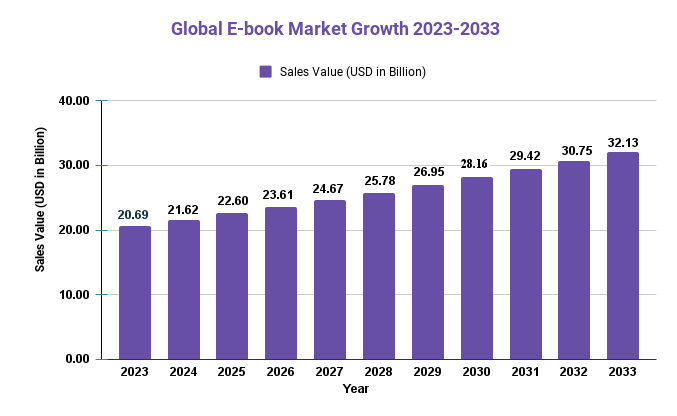E-book Market’s Leading Vendors, Amazon, Apple, McGraw Hill and More

Page Contents
Published Via 11Press: In 2023, the global E-book market was valued at approximately USD 19.80 billion and was expected to reach USD 30.75 billion by 2033, growing at a CAGR of 4.5% between 2023 and 2033.
The growth of the E-book market can be attributed to several factors, including the increasing adoption of smartphones, tablets, and e-readers, as well as the convenience and accessibility of E-books compared to traditional books. Additionally, the COVID-19 pandemic has accelerated the shift towards digital reading, as people have been spending more time at home and are looking for ways to stay entertained and informed.
Request For Sample Report Here: https://market.us/report/e-book-market/request-sample
Key Takeaway
- The E-book market is on the rise with significant potential for further expansion. The growing adoption of digital devices, the convenience of E-books, and the COVID-19 pandemic have all contributed to this growth trajectory.
- North America is currently the leading market for E-books, but Asia Pacific is expected to experience rapid expansion over the coming years.
- With technological advancements and shifting consumer preferences, the E-book market is expected to keep growing, offering publishers, authors, and other stakeholders in the book industry an opportunity to benefit from this development.

Regional Snapshot
- North America: North America was the leading market for E-books, accounting for the largest share of global revenue. The US led in terms of E-book revenue thanks to the high penetration of digital devices and major E-book retailers like Amazon.
- Europe: Europe was the second-largest market for Ebooks, with countries such as the UK, Germany, and France contributing significantly to its expansion. This growth was spurred on by factors such as increasing digitalization and the growing adoption of e-readers across various European regions.
- Asia Pacific: The E-book market in Asia Pacific is expected to experience significant expansion over the coming years. China and Japan were leading countries by revenue generated from E-books within the region, due to factors such as rising smartphone and tablet penetration rates and higher internet penetration levels.
- The Rest of the World: Countries such as Brazil and South Africa are expected to witness significant growth in the E-book market due to increasing digital device adoption and self-publishing becoming more commonplace.
Drivers
- Digital devices are being more widely used: With the increasing use of tablets and smartphones, it is easier to access and read Ebooks. This has led to market growth.
- E-books are convenient and accessible. E-books can be downloaded easily and read on many devices making them a popular choice for those who are always on the move.
- Consumer preferences are changing: Consumers increasingly want personalized experiences that are interactive and personal. E-books can help them by offering interactive content, multimedia, and social sharing.
- Self-publishing is gaining popularity: With the rise of self-publishing, it has become easier for authors to publish and distribute their work digitally. This has led to a greater selection of Ebooks available to consumers.
- Impact of COVID-19 – The COVID-19 epidemic has increased the adoption of digital reading. People are spending more time at home, and looking for new ways to be entertained and informed.
Restraints
- Dependence on Digital Devices: The growth of the E-book market is heavily dependent upon the adoption and usage of digital devices such as smartphones, tablets, and E-readers. Any slowdown in this adoption or usage could negatively affect growth in this space.
- Intellectual Property Issues: Intellectual property issues, such as piracy and unauthorized distribution of E-books, remain a significant challenge for the E-book market. Not only can this lead to a loss of revenue for publishers and authors, but it may also negatively affect the quality of books available on the platform.
- Limited Access to E-books: Although the number of electronic books has grown steadily over time, there remain limitations in terms of selection and accessibility for certain titles – especially those out of print or not digitized.
- Pricing and Subscription Models: Pricing and subscription models can be a barrier for the E-book market. Customers may be unwilling to pay high prices for ebooks, while subscription models may not be sustainable in the long term for publishers and authors.
- Preference for print books: Despite the convenience and accessibility of E-books, many readers still prefer print books and may not be ready to fully transition to digital reading yet.
Opportunities
- Global Expansion: The E-book market has the potential for global expansion, as more people gain access to digital devices and the internet in developing countries. This offers publishers and authors with an unprecedented opportunity to reach a broader audience and tap into new markets.
- New Revenue Streams: The E-book market provides publishers and authors with multiple methods of monetization, such as selling directly to consumers through websites or taking advantage of digital subscription services.
- Enhancing Reader Experiences: E-books offer readers the unique ability to customize their reading experiences through interactive features, multimedia content, and social sharing options. Publishers and authors can take advantage of these capabilities to create more captivating and personalized reading experiences for their customers.
- Self-publishing: Self-publishing has given authors new ways to reach readers through electronic books, bypassing traditional publishing channels and connecting directly with readers while still having control over their content and distribution.
- Personalization: E-books give readers the power to customize the content according to their preferences and behavior. Publishers and authors can take advantage of this by creating materials tailored specifically for certain audiences, providing a more captivating reading experience for all readers.
Inquire more or share questions if any before the purchase on this report at | https://market.us/report/e-book-market/#inquiry
Challenges
- Digital Rights Management: Digital rights management (DRM) is a major challenge facing the E-book market. Publishers and authors must guarantee their content is secure from piracy or unauthorized distribution while also offering readers an enjoyable reading experience.
- Fragmentation: The E-book market is highly fragmented, offering multiple formats and platforms for digital reading. This can lead to confusion among consumers as well as make it challenging for publishers and authors to distribute their content efficiently.
- Competition from Other Media: The E-book market faces competition from other forms of digital media, such as audiobooks, podcasts, and streaming video. This could cause a shift in consumer preferences and result in decreased demand for E-books.
- Reader Preferences: While many readers have adopted E-books, others still favor print books and may be hesitant to make the full transition into a digital reading. This presents publishers and authors with a challenge in catering to such an eclectic reader base.
- Pricing: Pricing in the Ebook market poses a challenge, as consumers often hesitate to pay high prices for digital content. Publishers and authors must find a balance between offering competitive prices and generating enough revenue to sustain their businesses.
Recent Development
- Subscription Services: Subscription services such as Kindle Unlimited, Scribd, and Audible have become increasingly popular in the E-book market. These subscription options give customers unlimited access to an extensive library of E-books and audiobooks for a monthly fee, making reading more accessible and convenient than ever for avid readers.
- Enhancements: E-books now boast enhanced features like multimedia, interactive elements, and social sharing capabilities that make reading an enchanting and thrilling experience for readers.
Key Market Segments
Type
- Ebook Reader
- Smart Phone
- Other
Application
- Hardware App
- Online Store
- Other
Key Market Players
- Amazon
- Apple
- McGraw Hill
- Sybex
- Beacon Press
- Adobe Press
- John Wiley & Sons
- Penguin Group
- Blackwell Science
- Random House
- Springer
- Bertelsmann
- Sony
- IReader Technology
Frequently Asked Question
Q: What is the current market size for the E-book market?
A: According to a report by Market.us, the E-book market was valued at USD 19.80 billion in 2023 and is expected to reach USD 30.75 billion by 2033, growing at a CAGR of 4.5% during the forecast period.
Q: What are the key segments of the E-book market?
A: The E-book market can be segmented based on Type (Ebook Reader, Smart Phone, Other), By Application (Hardware App, Online Store, Other), and geography (North America, Europe, Asia-Pacific, Latin America, and Middle East & Africa).
Q: Who are the key players in the E-book market?
A: Some of the key players in the E-book market include Amazon, Apple, McGraw Hill, Sybex, Beacon Press, Adobe Press, John Wiley & Sons, Penguin Group, Blackwell Science, Random House, Springer, Bertelsmann, Sony, IReader Technology.
The team behind market.us, marketresearch.biz, market.biz and more. Our purpose is to keep our customers ahead of the game with regard to the markets. They may fluctuate up or down, but we will help you to stay ahead of the curve in these market fluctuations. Our consistent growth and ability to deliver in-depth analyses and market insight has engaged genuine market players. They have faith in us to offer the data and information they require to make balanced and decisive marketing decisions.



